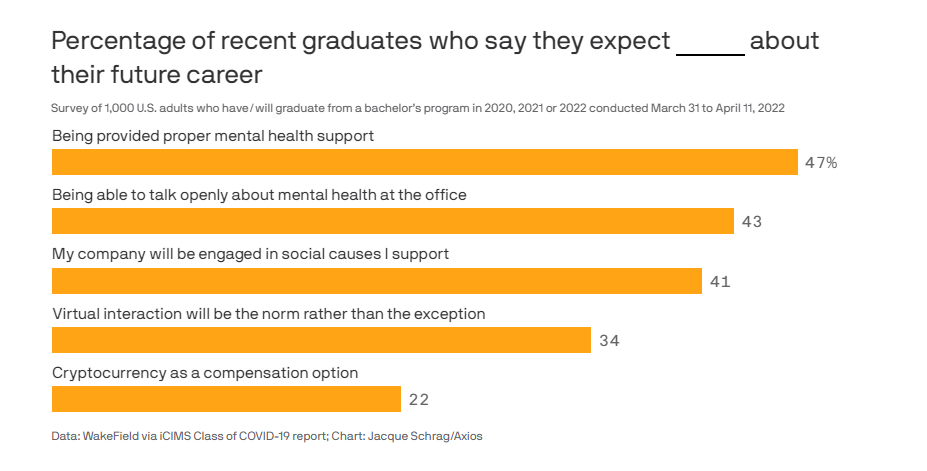Even industry leaders aren't sure how to approach remote work. Should employees get ready for a mass return to offices?
Apple lost their top machine learning expert due to inflexible work rules. AirBnB got over a million visits to their career page after announcing a fully flexible, work-where-you-want work policy.
If even market-leading companies can’t come to a consensus, how should you approach remote work? One thing is for sure, your company needs to become more flexible if you want to attract and retain top talent.
Keep reading to find out exactly why!
Table of contents:
- Short History of Remote Work
- The Main Ingredient of Efficiency and Productivity in Remote Work
- How to Make Remote Work Safe and Secure
- Remote Work Facts and Myths
- Without Support Systems, Remote Work Is Depressing
- Summary
Short History of Remote Work
Remote work really isn’t as new as some people seem to think. IBM had about 2,000 remote employees in 1983—before the internet happened!
In 1985, the media were already reporting on the “telecommuting movement”, and the new era of “telecommuting” that was about to revolutionize the world. In 1989, management guru Peter Drucker stated that “commuting to office work is obsolete.”
So, the idea isn’t new, and yet it took a long time before other organizations started treating remote work seriously, let alone implementing it.
It’s easy to see why. Online collaboration tools took off after 2000, with the growing power of PCs as well as increasing internet speeds. Working from home on a dial-up modem in the 1990s would’ve been a huge pain!
Between the years 2000 and 2020, remote work steadily grew in popularity, but it was still seen as a privilege. Something you had to fight for, something that was usually reserved for the best of the best, or people who physically couldn’t commute to the office.
We all know what happened in 2020, and how it changed our perspective on the modern workplace.
Now that the pandemic is “kind of” over, it seems that nobody is sure what to do, but some trends are clearly emerging.
IBM, along with HSBC and Salesforce, don’t want remote work to be the new norm—instead, they’re banking on flexibility.
They see an opportunity to improve the workplace by adding the option to work remotely some of the time, but they don’t plan on becoming fully remote. They’re also looking at how to improve their offices to increase employee collaboration and engagement.
It makes sense that the modern workplace should be more flexible. Not everyone wants to work remotely, and the old office model was archaic. There’s plenty of room for innovation.
If you want to create a workplace that will attract top talent, updating the work model isn’t really an option—it’s a necessity.
Apple learned this lesson the hard way. After they rolled out a hybrid work week with a requirement of 3 days in-office per week, they lost their top machine learning engineer and made many employees unhappy.
On the other hand we have AirBnB. They recently announced their remote work policy, which essentially states that AirBnB employees can work from anywhere without any adjustment in income based on cost-of-living.
The result? During an earnings call, Brian Chesky reported that:
"The response internally was great, but even more impressive with the response externally, because our career page was visited 800,000 times after that announcement."
Companies like Facebook, Walmart, Quora, Shopify are embracing the remote work movement. Even traditional, huge financial institutions like JPMorgan and Credit Suisse are embracing remote work to some degree.
So, if there’s one thing to be learned from all this, it’s that employees demand flexibility.
If you don’t want to lose your top performers, you need to be ready to provide them as much flexibility as they need—but you don’t necessarily need to become a 100% remote organization because of it.
The Main Ingredient of Efficiency and Productivity in Remote Work
“Deep Work” author Cal Newport wrote a great article for The New Yorker about how to create a good environment for sustainable, efficient remote work.
He researched a remote work program that Best Buy ran between 2005 and 2013. Over the course of the program, employees became happier, productivity rose, and there was nothing to indicate that remote work hurt the organization.
To make it work, they had to overcome a few huge challenges. It turns out that the biggest challenges were interpersonal:
- Managers didn’t know how to evaluate job performance,
- There was a lot of fear that people would simply avoid work when at home,
- The office culture caused in-office workers to be resentful of remote workers.
The secret key that made it all work, and which makes it work in modern remote organizations, is result-focussed management.
Traditional management styles are focussed on employee surveillance, and they don’t work when applied to remote workers.
To enable productivity in remote work, you need to adopt a completely new culture. Managers and employees need to make a huge mindset switch, and they won’t be able to do it without help.
There’s nothing more difficult than changing people’s minds, which makes this the most critical challenge of implementing remote work.
You can come up with all the systems, policies, and tools that you want, all of this alone still won’t do the job.
The most important thing is to educate your managers about what matters in remote work, and according to Cal Newport, it’s these two things:
- Clearly defined outcomes,
- Trust.
Keep this in mind as your starting point on the path to building a productive remote work environment.
How to Make Remote Work Safe and Secure
One of the biggest issues with remote work is figuring out how to do it safely and avoid cybersecurity pitfalls. Cybersecurity is hard to maintain.
Even the most secure system can be infiltrated, because hackers don’t really break code—they break people.
Take the recent Verizon hack as an example. The hacker social-engineered his way into stealing employee data from the American telecom giant. He didn’t need crazy malware or genius-level coding skills at all:
- he pretended to be from internal support,
- got an employee to provide remote access to their computer,
- installed a script to steal data,
- demanded a ransom of $250,000 and called Verizon employees idiots.
So, if you want to create a secure remote work environment, here's a quick 4-step guide on how to start:
1. Implement Continuous Cybersecurity Education And Procedures
Without educating your workforce, investing in any cybersecurity systems will be a futile effort, no matter how advanced protection they offer.
On the other hand, if everyone in your company knows several cybersecurity rules by heart, your organization will be safer than ever.
For example, opening links in email or chat messages. Such a small thing, right? No smart person that works in the tech industry would ever click a harmful link!
Think again. Even the Bored Ape Yacht Club, supposedly at the forefront of digital technology and NFT trading, fell prey to this simple, extremely effective tactic.
With a bit of social engineering and some fake links, hackers were able to steal almost $300,000 from the pioneer, innovative, disruptive NFT organization. And it happened to them more than once!
If even the gurus of technology, geniuses of selling blockchain-based JPGs can be so easily manipulated, then the chances of your employees being manipulated by hackers are pretty huge.
There’s no jumping around this, there are no shortcuts or silver bullets to solve this issue. If you want to protect your organization, you simply need to educate your employees—not once, but on a long-term basis.
To make your company even more secure, you need to also have procedures in place to quickly put an end to any malicious activity going on in your systems, but that's a topic for a completely different article.
2. If Possible, Provide Work Equipment for Your Employees
If you have the funds for it, it’s always a good idea to buy work computers (and any other necessary devices) for your employees.
This way, you can set these devices up with security settings and software that will mitigate hacking risk.
Plus, this comes with a mental health benefit for remote workers!
Switching from “work mode” into “rest mode” can be difficult for people that work at home. Having a separate device that’s only for work can be a good way to imitate the feeling of exiting the office and letting go of work for the day.
3. Take Access Management Seriously
Many organizations, especially SMBs, don’t pay enough attention to managing access privileges in their systems.
As a result, employees that no longer work at a company might still be able to log into company software or social media profiles. This kind of thing should never happen in a professional environment!
The basic blueprint for access management looks like this:
- Keep track of all employee accounts,
- Make sure that employees use secure passwords and multi-factor authentication,
- Revoke all access to company systems as soon as someone exits the company.
But that’s not all, because there’s a new type of hacker attack that was only recently revealed by Microsoft security experts—pre-hijacking of web accounts.
Basically, hackers can take control of new employee accounts before they’re even created. This makes proper access management more important than ever, so don’t ignore this if you don’t want to be hacked!
4. Be Careful Not to Hinder Remote Software Development
Software development is the most tricky area when it comes to secure remote work. You can’t control developer access too much, because it could break the flow of development.
You can’t enforce too many or too stringent cybersecurity tools or procedures, because they’ll turn the developer’s workday into red tape hell.
As a rule of thumb, developers are harder to manipulate compared to other types of office workers. They might snicker at your efforts to make their work more secure, because they usually have more knowledge in this area, and they know how to do their work in a safe way.
The worst possible situation here is when a non-technical manager imposes stringent, intrusive security systems for technical teams.
A situation like this can breed resentment, break the development flow, and create a whole lot of toxicity in your company.
To avoid this entirely, you simply need to cooperate with your technical teams when it comes to implementing security systems and procedures.
It will make the process longer and more difficult, there will be more feedback and discussions, but eventually you will arrive at a point where both management and technical staff are happy with the cybersecurity infrastructure.
The worst thing you could do is come out of the blue one day and simply order all technical staff to abide by your new cybersec policy—so avoid this situation at all costs!
Remote Work Facts and Myths
We’re in the early stages of a remote work revolution. There isn’t a step-by-step playbook, there are no clear rules, and it’s unclear whether your organization should adopt remote work.
Because there’s so little formalized knowledge about remote work, most of us just wing it. This leads to the creation and proliferation of many myths. Let’s analyze some of them and see if they hold up to scrutiny.
1. Remote Workers Are More / Less Efficient
The Economist reports that “work that is largely done remotely may be more efficient compared with an office-first model”.
The keyword is “may”. The article compares different studies of remote work productivity, and they present a mixed picture.
Some studies show that people were able to do more when forced to go remote because of the pandemic.
Other studies, including a big study of 60,000 Microsoft employees, show that remote work contributes to “static and siloed” cooperation, and it might stifle innovation in the long term.
At the moment, nobody can confidently say that going fully remote improves productivity. So, if you hear that remote work is or isn’t good for productivity, always take it with a grain of salt.
The best advice for now is to be careful, and take the time to work out proper remote work practices that fit into your business context and company culture.
Simply telling your employees that they can work from home is not enough. You need to also:
- Ensure that remote workers have a comfortable workspace (even a good desk and ergonomic chair can make a huge difference)
- Provide mental health support and help remote workers socialize with each other (for example, you could rent a workation retreat for your workers to get together)
- Maintain cybersecurity best practices (people are easier to hack than software, so you need to educate employees about safe remote work, and warn them about attacks like phishing or man-in-the-middle)
2. Remote Workers Pretend to Work
You’ve surely seen or heard about Elon Musk’s statement to Tesla executives. Basically, he announced that nobody at Tesla can work from home, and anyone who disagrees can leave the company.
When asked what remote work enthusiasts at Tesla should do, he responded “they should pretend to work somewhere else”.

Whether it will turn out to be a positive decision for Tesla, only time will tell. But should you follow Elon's advice, and completely forbid remote work in your organization?
The answer depends on your company culture and management style.
For an established organization with a long-standing culture of in-office work, a sudden shift to remote work might be a big shock to the system.
For an innovative, bootstrapped start-up that needs to save every penny in the budget, remote work might help streamline growth while saving money.
Now, how do you tell if your remote workers are slacking or actually putting in the work?
Should you invest in software that monitors all of their activity? Should you force them to do daily meetings to report what they’re working on?
It all boils down to your management style and the way you evaluate employees. Ask yourself these questions:
- Is it possible that in-office employees always had downtime during the workday, it just wasn’t clear because you could see them pretending to be busy?
- Would you be able to work out a way to evaluate your employees by value added, and not just their working hours?
People are great at gaming systems to their advantage. We all do it everyday. If we see a way to work less and still earn the same, we’ll do it.
Ultimately, the question of whether remote employees pretend to work or not is focusing on the wrong thing.
If you want to avoid this problem, flip the question around and ask yourself “is there a better way to evaluate my employees instead of having them report work hours spent on tasks?”.
You could evaluate by value added. Or simply by task completion, with unique monthly quotas for every employee.
So, ultimately, the answer is yes—if you don’t pay attention, you create an environment where it’s easy to game the system and pretend to work. Your employees will take advantage of it.
It’s on you to build a remote work environment where any pretender is caught early, and productivity is rewarded.
3. Remote Work Is Easier to Manage
Bloggers, journalists and Linkedin influencers are getting more vocal about how remote work is the new normal. This is a problematic statement.
Many jobs can’t be done remotely. Surgeons, construction workers, truck drivers, factory workers, the list goes on. In these cases, it’s obvious that remote work isn’t the new normal, and never will be.
The jobs that interest us the most only require a computer and internet connection.
For these jobs, remote work was becoming normal even before the pandemic. But, many remote workers will tell you that it’s not always smooth sailing—especially for digital nomads.
A digital nomad is someone who travels to distant corners of the world and doesn’t work in the same country that your company is based in.
This can create unusual issues with:
- Finding the right way to pay income tax,
- Visa issues,
- Abiding by local employment laws.
It can get quite problematic. The Economist provides a good example, reporting about a couple that wanted to move from the US to India. As it turned out, this could force their company to set up a base in India, which would mean dealing with unnecessary red tape and extra costs.
Problems like this can compound, and make remote work less attractive for the organization.
Plus, employment laws around the world will take a few years to catch up to remote work. Until there’s a clear legal playbook for remote work, organizations will have to create and rely on their own policies to satisfy remote worker needs.
Then there are more obvious issues. For example, should you cut the pay of employees who work from a location with lower costs of living? Should you enforce software that tracks everything your remote employees do throughout the work day?
All in all, a remote workforce might be more difficult to manage than an in-office workforce. It’s up to you to decide if it’s worth it for your organization.
Without Support Systems, Remote Work Is Depressing
When your whole team works together in an office, many magical things happen that might go unnoticed.
All those small chats that happen around the office, trying out a new place for lunch with a few colleagues, sitting in on a meeting, talking about things that aren’t work-related—all of this seems small, but these small things eventually compound into a strong team spirit.
These magical little moments can be replicated in remote work, but it won’t happen automatically. You need to design and implement support systems for your remote employees.
This is particularly visible when you talk to young people that entered the workforce during the pandemic. As reported by Anne Helen Petersen and Charlie Warzel, authors of the book “Out of Office”, many young people struggled in remote work environments.
Remote work made some generation Z workers feel like they weren’t hired at all. They felt lost, unable to navigate this unusual work environment.
Not everyone can excel as a remote worker. Those of us that are more introverted will have an easier time, but even introverts can get burnt out from an ill-prepared remote work environment.
So the big question here is:
What does a properly prepared remote work environment look like?
The socialization part of your work environment suffers the most. To create a remote environment where workers can flourish, there are several things you can do:
1. Mentorship Programs
Employees want to grow and feel included in the organization. If they only connect with their manager, they might feel alienated. After all, managers constantly evaluate employees, so it’s hard to have a real connection.
That’s why, especially for the youngest employees, it’s good to have a mentorship program in place. Assign workers to each other so that they have someone to ask all those uncomfortable questions that they’re too shy to ask their managers.
Mentorship programs are a great way to ensure knowledge exchange within your company, as well as keep remote employees connected.
2. Bonding Without an Agenda
Work-related meetings aren’t a good way for people to bond. In an office, employees bond naturally. This is hard to replicate in remote work.
For this to work, you need to create space for people to come together without enforcing a work-related agenda.
Maybe a book club, where people can have a weekly get-together to read and discuss books on company time?
Or regular company-funded trips to interesting places?
Think about it this way—remote work means that you don’t have to spend a lot on a huge office that will fit all of your employees.
The money that you save on an office space can now be spent on integrating your workers and bringing them closer together in new, innovative ways.
3. Support Systems
Mental health is more important than ever. The world is a scary place, especially for young people who are plugged into world news 24/7/365, but older workers aren’t exempt from mental health issues either.
Supporting your workers during tough times is not a perk or benefit, it’s a necessity. When you’re having a difficult time, it’s not easy to reach out and ask for help, especially to your manager or employer.
That’s why, if you truly want to care for your remote employees, you need to implement support systems that make it easy, quick and painless to ask for and receive help with mental health issues.
Mental health is no longer taboo. Younger workers simply demand that employers take care of their wellbeing. Older workers aren’t as open about it, but when you offer them support, they will surely take you up on it as well.
As reported by Axios, young workers crave stability and long-term employment, but only at a workplace that respects them and supports them. If their needs aren’t met, they have no trouble quitting and looking for a better place.
Summary
It’s clear to see that remote work is definitely not a fad, but it’s also not the “new normal”. Not everybody enjoys remote work, not all managers know how to organize it, and sometimes it can hurt innovation and collaboration.
But, when implemented correctly—and only then—remote work can do wonders for employee productivity and happiness.
So, if there’s one thing that’s changed, it’s that companies need to be prepared to offer flexibility to the employees that demand it. Otherwise, you risk losing top talent and making your existing workforce resentful.
Read more:
➤ All You Need To Know About Low-Code And No-Code
➤ Cybersecurity - Your New Priority. Basic Guide to Cybersecurity in Online Business
➤ Executive Primer On Metaverse—What Is It? Should You Invest?











 Angry Nerds (Poland)
Angry Nerds (Poland) Angry Nerds (USA)
Angry Nerds (USA) Angry Nerds (Canada)
Angry Nerds (Canada)



